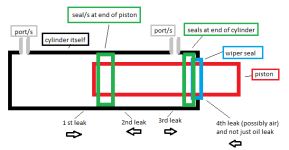brain55
Veteran Member
Obviously this is true for boom cylinders where the weight of the boom is applying force to the fluid on the base side of the piston opposite of the rod. I've seen people try to use the same physics on bucket cylinders, which doesn't work. The load on bucket cylinders is trying to pull the rod out. Rod side displacement is less so there is no way it can ever equalize.
I will say this. In 27 years as a mechanic working on utilty tractors and equipment, I have replaced very few control valves. If they needed to be replaced it was typically from metal contamination (transmission failure etc.) or somebody bending a spool (abuse).
Brian
I will say this. In 27 years as a mechanic working on utilty tractors and equipment, I have replaced very few control valves. If they needed to be replaced it was typically from metal contamination (transmission failure etc.) or somebody bending a spool (abuse).
Brian
Last edited:


